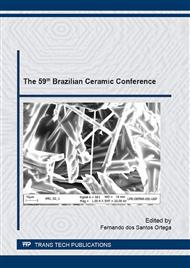p.416
p.422
p.427
p.433
p.441
p.447
p.453
p.459
p.464
Morphological Characterization of Nickel-Silica Nanocomposite in Residual Carbon Obtained by Direct Polymeric Route
Abstract:
Nickel-silica nanocomposites can be obtained by direct chemical route, such as the Polymeric Precursor Method. That methodology type permits to obtain material powders with significant specific area and porosity suitable for reactive gases or fluids permeation, which are required characteristics for application in heterogeneous catalysis process. The composite material obtained from pyrolysis of polymeric precursor has its porosity strongly dependent from precursor constitution, which affects the decomposition kinetic. In this study, it was obtained a polyester precursor based on triethylene glycol, which has been submitted at pyrolysis at 600 oC for several times in nitrogen atmosphere. The nickel-silica nanocomposite obtained through that methodology presents a residual amorphous carbon phase playing an important rule on the mechanism of pore formation. Nickel nanoparticles nucleate with sizes close to 10 nm in diameter and are highly dispersed in a hybrid amorphous carbon-silica matrix. The composite pore volume, calculated through the JBH method, presents a continuous increasing as a function of pyrolysis time, reaching more than 0.15 cc/g after 7 hours from initial decomposition process.
Info:
Periodical:
Pages:
441-446
Citation:
Online since:
November 2016
Keywords:
Price:
Сopyright:
© 2017 Trans Tech Publications Ltd. All Rights Reserved
Share:
Citation:


